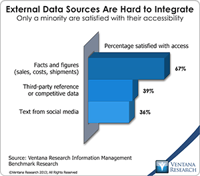Blockchains are attractive because their built-in security and trust factors make them useful for almost all business interactions involving organizations and individuals. Blockchains have two basic functions. One is as a method for handling transactions involving property such as land deeds, trademarks or other assets. The second involves exchanges of data such as identities of individuals or businesses, the location of an object at a point in time or weather conditions. All interactions...
Read More
Topics:
Big Data,
Data Science,
Mobile,
Marketing Performance Management,
Office of Finance,
Analytics,
Business Intelligence,
Cloud Computing,
Data Governance,
Data Integration,
Data Preparation,
Internet of Things,
Digital Technology,
Digital Marketing,
Digital Commerce,
Operations & Supply Chain
Oracle recently held its second ERP Cloud Summit with industry analysts. The all-day event wasn’t just about ERP. The company covered a range of its business applications, including financial performance management as well as its Adaptive Intelligent Applications. And it wasn’t just about the cloud. After more than a decade of steady developments, ERP systems have begun to change fundamentally, facilitated by the growing availability of new technologies including cloud computing, advanced...
Read More
Topics:
Big Data,
Data Science,
Mobile,
Customer Experience,
Human Capital Management,
Machine Learning,
Office of Finance,
Analytics,
Data Integration,
Internet of Things,
Cognitive Computing,
HRMS,
Financial Performance Management,
Mobile Marketing Digital Commerce,
Digital Marketing,
Digital Commerce,
Operations & Supply Chain,
Enterprise Resource Planning,
ERP and Continuous Accounting
Business process reengineering was a consulting fashion in the early 1990s that spurred many companies to purchase their first ERP systems. BPR proposes a fundamental redesign of core business processes to achieve substantial improvements in market and customer responsiveness, productivity, cycle times and quality. ERP systems support business process reengineering by guiding the step-by-step execution of the redesigned process to ensure that it is performed consistently. They also automate the...
Read More
Topics:
Big Data,
Data Science,
Mobile,
Customer Analytics,
Customer Experience,
Machine Learning,
Office of Finance,
Wearable Computing,
Continuous Planning,
business intelligence,
Analytics,
Cloud Computing,
Data Integration,
Internet of Things,
Financial Performance Management,
Digital Technology,
Digital Marketing,
Digital Commerce,
Operations & Supply Chain,
Enterprise Resource Planning,
Machine Learning and Cognitive Computing,
ERP and Continuous Accounting,
Sales Planning and Analytics
One of the potential benefits of cloud computing to access business applications and data is its potential to improve the situational awareness of executives and managers. By this I mean their understanding of what’s going on outside their company in addition to what’s happening within it. Today people have access to a trove of information about their own company, which is the result of decades of investment in an expanding range of enterprise transaction systems (ERP, CRM and supply chain...
Read More
Topics:
Operational Performance Management (OPM),
Cloud Computing,
Data Integration,
Data Management,
Business Performance Management (BPM),
Customer Performance Management (CPM),
Data,
finance,
Financial Performance Management (FPM),
Information Management (IM),
Sales Performance Management (SPM),
Supply Chain Performance Management (SCPM),
Workforce Performance Management (WPM),
FPM
IBM this week announced its pending acquisition of the Star Analytics product portfolio. Star Analytics is a privately held company that offers products designed to provide easy access to and integration with Oracle Hyperion data sources. While Star Analytics has a good product and solid references, it has lacked critical mass to support more effective sales and marketing efforts. Star Analytics’ strategic value to IBM lies in its ability to unlock data held in Oracle Essbase multidimensional...
Read More
Topics:
Reporting,
closing,
Essbase,
Hyperion,
Analytics,
Business Analytics,
Business Collaboration,
Data Integration,
IBM,
Oracle,
Business Performance Management (BPM),
Financial Performance Management (FPM),
Information Management (IM),
Financial Performance Management,
Star Analytics,
TM1
My colleague Mark Smith and I recently chatted with executives of Tidemark, a company in the early stages of providing business analytics for decision-makers. It has a roster of experienced executive talent and solid financial backing. There’s a strategic link with Workday that reflects a common background at the operational and investor levels. As it gets rolling, Tidemark is targeting large and very companies as customers for its cloud-based system for analyzing data. It can automate alerts...
Read More
Topics:
Big Data,
Data Warehousing,
Master Data Management,
Performance Management,
Planning,
Predictive Analytics,
GRC,
Operational Performance Management (OPM),
Budgeting,
Risk Analytics,
Analytics,
Business Analytics,
Business Collaboration,
Business Intelligence,
Business Mobility,
Cloud Computing,
Data Governance,
Data Integration,
In-Memory Computing,
Information Management,
Mobility,
Business Performance Management (BPM),
Customer Performance Management (CPM),
Financial Performance Management (FPM),
Risk,
Sales Performance Management (SPM),
Workday,
Workforce Performance Management (WPM),
Financial Performance Management,
Integrated Business Planning,
Strata+Hadoop















